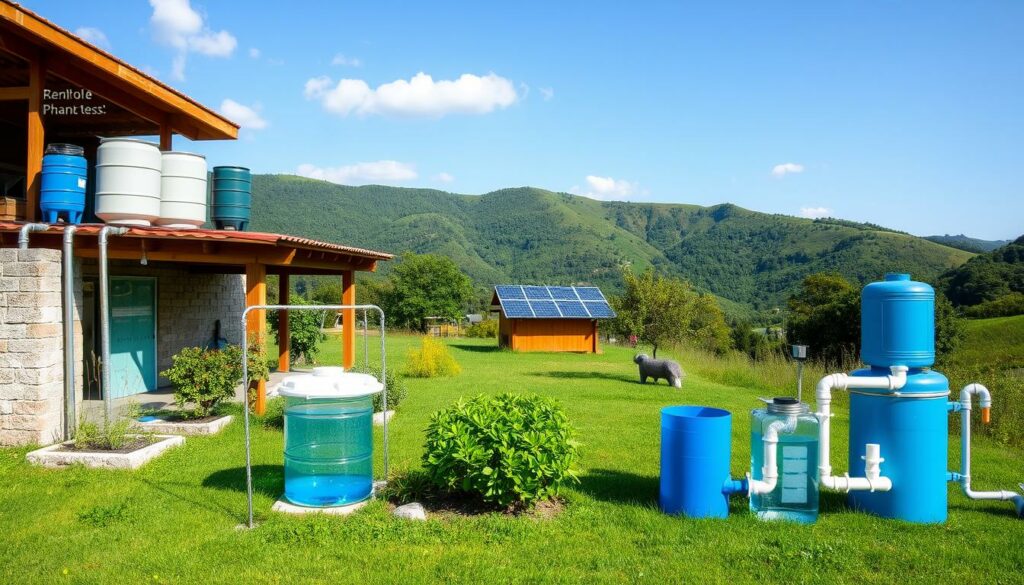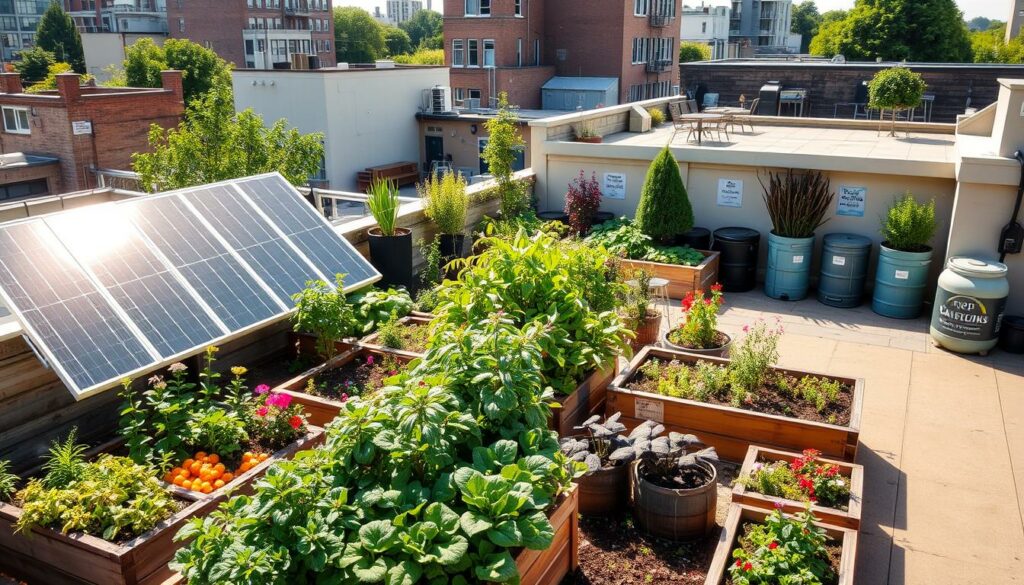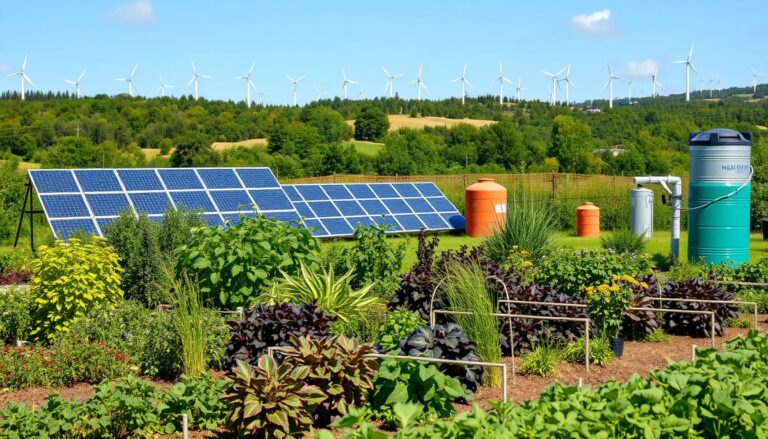Our world is facing big environmental challenges. Eco-friendly prepping is now key to getting ready for emergencies in a green way. With climate change making over 20 million people homeless each year, we must focus on lasting sustainability in our emergency plans.
Green prepping mixes caring for the planet with being able to take care of ourselves. It helps us lower our impact on the environment while getting ready for emergencies. We do this by using sustainable ways to make energy, save water, store food, and handle waste.
By choosing eco-friendly prepping, we help ourselves and the planet. For example, using LED light bulbs can cut down on carbon emissions by up to 40kg a year. Also, there are many energy-saving appliances that make it easier to use less energy.
Key Takeaways
- Eco-friendly prepping combines sustainability with emergency preparedness
- Climate change displacement affects over 20 million people yearly
- LED bulbs can reduce carbon emissions by 40kg annually
- Energy-efficient appliances are now widely available
- Green prepping focuses on sustainable energy, water, food, and waste management
- Adopting sustainable practices ensures both personal and environmental resilience
Understanding the Importance of Sustainable Prepping
Sustainable prepping is a smart way to get ready for emergencies. It’s good for you and the planet. By using eco-friendly methods, you can lessen your impact on the environment. At the same time, you’ll be prepared for any unexpected events.
Environmental Benefits of Eco-Friendly Preparation
Being eco-friendly in emergency prep protects our natural resources. For instance, meal prepping can greatly reduce food waste. Did you know that 38% of all food in the U.S. ends up in the trash? Planning your meals helps you avoid this waste and saves money.
Long-Term Advantages for Self-Sufficiency
Sustainable prepping builds self-reliance. Skills like collecting and purifying rainwater can give you a steady water supply in emergencies. This is vital, as most of Earth’s water isn’t safe for drinking due to pollution or salt.
Reducing Carbon Footprint While Preparing for Emergencies
Lowering your carbon footprint is key in sustainable prepping. Choosing plant-based foods can make a big impact. Plant-based meat produces 30%-90% less greenhouse gas than traditional meat. This change is good for the planet and your health.
| Sustainable Prepping Practice | Environmental Benefit | Personal Benefit |
|---|---|---|
| Meal Prepping | Reduces food waste | Saves money and time |
| Rainwater Collection | Conserves water resources | Ensures water supply in emergencies |
| Plant-Based Diet | Lowers greenhouse gas emissions | Promotes healthier eating habits |
By choosing sustainable prepping, you’re doing more than just getting ready for emergencies. You’re also helping make the planet healthier and ensuring a stronger future for all of us.
Sustainable Energy Solutions for Preppers
Preppers are now choosing renewable energy for living off the grid and getting ready for emergencies. With electric bills going up and new rules from the government, many are looking for other options. Let’s look at sustainable energy choices that give you freedom and are good for the planet.
Solar Power Systems for Off-Grid Living
Solar power is becoming more popular among preppers. It makes up 2.2% of the electricity in the U.S., which is a big deal. Almost 80% of those living off the grid use solar power for keeping food cold, which saves them about 30% compared to regular fridges.
Wind Energy Options for Sustainable Power Generation
Wind energy is a clean and affordable way to make power. It’s perfect for preppers who want reliable alternatives. Wind turbines can make electricity even when the sun isn’t out, which helps with solar systems.
Portable and Renewable Energy Sources for Emergencies
Portable energy is key in emergencies. Most preppers, 85%, use battery banks to store energy. Golf cart batteries usually last 5-7 years, and L16 batteries can last up to 10 years if taken care of right.
| Energy Source | Advantages | Maintenance |
|---|---|---|
| Solar Power | Clean, abundant, silent | Minimal (panel cleaning) |
| Wind Energy | 24/7 potential, cost-effective | Annual inspection |
| Battery Banks | Portable, reliable storage | Quarterly checks |
| Hydropower | Constant output, long-lasting | Regular debris removal |
By using these renewable energy sources together, preppers can make a strong, sustainable power system for living off the grid and in emergencies.
Water Conservation and Purification Techniques
Water is a precious resource, with only half a percent of Earth’s freshwater available for human use. This scarcity highlights the need for sustainable water management in prepping. Techniques like rainwater collection, purification, and conservation are key for survival and caring for the environment.

Rainwater collection helps supplement your water supply. By harvesting rainwater, you lessen your dependence on city water and prepare for emergencies. Simple systems can collect thousands of gallons a year, perfect for non-drinking uses like gardening and cleaning.
Water purification is vital for making water safe to drink. Boiling is a basic method, but advanced techniques like reverse osmosis and UV sterilization are more effective. These methods can make water safe for most household uses. For special needs, ultrapure water systems are available but need a lot of resources.
| Water Type | Purification Method | Application |
|---|---|---|
| Type 1 (Ultrapure) | Deionization, UV, Filtration | Lab use, Specialized Equipment |
| Type 3 | Reverse Osmosis | General Household Use |
Managing water sustainably goes beyond just collecting and purifying it. Using low-flow fixtures, fixing leaks, and adopting efficient practices can cut down on water use. In farming, no-till methods with high-residue improve soil’s water retention, reducing the need for irrigation.
“If the world’s water supply were 26 gallons, our useable freshwater supply would be half a teaspoon.”
By using these methods, preppers can have a steady water supply and lessen their environmental impact. Every drop is crucial in our quest for sustainable living and being prepared.
Sustainable Food Production and Storage
Sustainable food production and storage are key for long-term prepping and keeping our planet healthy. Agriculture is responsible for 40% of global methane emissions. It’s vital to use eco-friendly methods. Let’s look at some ways to keep food safe and lessen our impact on the environment.
Organic Gardening Methods for Long-Term Food Security
Organic gardening is a key part of sustainable food making. It avoids harmful chemicals to keep soil healthy and support many kinds of life. Begin with a small vegetable or herb garden. Use natural ways to control pests and add compost to your soil. This method gives you fresh, healthy food and lowers your carbon footprint.
Permaculture Principles for Sustainable Agriculture
Permaculture elevates sustainable farming. It builds ecosystems that work like nature does. Plan your garden to use space and resources well. Use water-saving methods like collecting rainwater. Plant different crops that help each other grow. This approach ensures a steady food supply and helps the environment.
Eco-Friendly Food Preservation Techniques
Storing food in a sustainable way cuts down on waste and keeps food available all year. Try drying, canning, and fermenting your food. These methods keep food fresh for longer without using a lot of energy. Choose glass containers for the fridge or freezer. For fresh produce, go for reusable bags. These steps help reduce plastic waste and food waste.
- Dehydrate fruits and vegetables for long-term storage
- Can homegrown produce to preserve nutrients
- Ferment foods for probiotic benefits and extended shelf life
- Use glass containers and reusable bags for storage
By using organic gardening, permaculture, and sustainable food storage, we can build a strong food system. This system meets our needs and helps the planet. These practices make sure we have food and help create a sustainable future.
Eco-Friendly Shelter and Housing Options
Sustainable shelter is key in green prepping. It cuts our carbon footprint and ensures comfort and resilience. Let’s look at some eco-friendly options that are both sustainable and practical.
Green building materials are the base of sustainable homes. They are often recycled, locally sourced, or have a low environmental impact. Examples include reclaimed wood, bamboo, and recycled steel. Using these materials can greatly reduce your shelter’s carbon footprint.
Being energy-efficient is crucial in sustainable homes. Double-glazed windows can reduce heat loss by up to 50%. Proper insulation keeps temperatures comfortable all year. LED and CFL bulbs use less energy and last longer than traditional bulbs.
“Sustainability is no longer about doing less harm. It’s about doing more good.” – Jochen Zeitz
Renewable energy is vital for energy-efficient homes. Solar panels make clean electricity and lessen our need for fossil fuels. Smart power strips help save energy by cutting power to devices on standby.
| Feature | Benefit |
|---|---|
| Double-glazed windows | Reduce heat loss by up to 50% |
| Solar panels | Generate clean electricity |
| LED/CFL bulbs | Greater energy efficiency, longer life |
| Smart power strips | Optimize energy use |
Water conservation is key in sustainable shelter. Using rainwater harvesting systems and greywater recycling can cut water use. These systems save resources and provide backup water in emergencies.
By adding these eco-friendly features, you can make a shelter that’s good for the planet. It’s not just about surviving. It’s about thriving with our planet.
Sustainable Waste Management for Preppers
Preppers face unique challenges in waste management during emergencies. Trash collection often stops in disasters, making proper waste handling key for health and safety. Let’s look at sustainable ways for preppers to handle waste well.
Composting Systems for Organic Waste
Composting is a big help for preppers. It turns organic waste into soil that’s full of nutrients, cutting down on landfill waste. A basic compost bin can take care of kitchen scraps and yard waste, making great soil for your garden. Composting toilets are also an option for managing human waste, turning it into something useful.
Recycling and Upcycling in a Prepping Context
Recycling and upcycling are important for preppers. Sort recyclables to lessen your waste. Be creative with upcycling – turn old containers into storage or use glass jars for food preservation. These methods not only cut down on waste but also save resources in emergencies.
Greywater Systems for Water Conservation
Greywater systems help save water. They use wastewater from sinks and showers for irrigation, making the most of limited water. A simple greywater system can be made with pipes to send water to your garden. This way, your plants will stay watered even when there’s an emergency.
Effective waste management is more than just getting rid of trash. It’s about starting a sustainable cycle that helps your prepping plans. By using these systems, you’ll keep your environment clean, lessen your impact on nature, and make your prepping strategy stronger.
Green Transportation Alternatives
Sustainable transportation is key for preppers and those who care about the planet. As we move towards a greener future, eco-friendly vehicles are becoming a big part of our plans. Let’s look at some options that can cut our carbon footprint and keep us moving in emergencies.
Electric vehicles (EVs) are at the forefront of sustainable transport. They produce no emissions and cost less to run. Many preppers are adding these cars to their plans, seeing their long-term benefits.
Hybrid cars offer a mix of efficiency and reduced emissions. They’re perfect for those who need to travel far but still want to be eco-friendly.
Bicycle preparedness is vital for green transport. Bikes don’t emit any pollution and are reliable when there’s no fuel or road blockages. Preppers should keep a strong bike and have spare parts ready for when you need to move by bike.
| Transportation Option | Environmental Impact | Emergency Preparedness Value |
|---|---|---|
| Electric Vehicles | Zero emissions | High, with proper charging solutions |
| Hybrid Cars | Reduced emissions | High, versatile for various scenarios |
| Bicycles | No emissions | Excellent, no fuel required |
| Fuel-Efficient Vehicles | Lower emissions | Good, extended range on limited fuel |
By choosing these green transport options, preppers can lessen their use of fossil fuels and lower their environmental impact. They can also stay mobile in emergencies. The goal is to pick options that meet both sustainability and preparedness goals.
Sustainable Prepping on a Budget
Being budget-friendly doesn’t mean you can’t be eco-conscious. With smart choices, you can prep sustainably without spending a lot.
Cost-effective Eco-friendly Prepping Strategies
Start by making smart choices for eco-prepping. Use reusable containers for your prepped meals. This reduces waste and saves money over time. Buying in bulk also helps by cutting down on packaging and often costs less per item. It’s good for your wallet and the planet.
DIY Sustainable Solutions for Preppers
DIY projects are great for budget-conscious preppers. Consider growing herbs in small spaces or raising chickens if you can. These activities provide fresh food and lower your carbon footprint. A simple rainwater collection system can also help save water and reduce your bills.
Balancing Sustainability and Affordability in Prepping
Finding a balance between eco-friendliness and cost is key. Try eating a plant-based diet one day a week. This small change can greatly reduce your environmental impact. It might also improve your health and lower your food costs.
| Strategy | Environmental Impact | Cost Savings |
|---|---|---|
| Meal Prepping | Reduces food waste | Saves on grocery bills |
| Reusable Containers | Decreases plastic waste | Eliminates need for disposables |
| Plant-based Day | Lowers carbon emissions | Reduces meat expenses |
By using these budget-friendly prepping tips, you’re doing more than saving money. You’re helping the planet and getting ready for any challenges that come your way.
Building a Resilient and Sustainable Community
Creating strong, adaptable communities is key to green prepping. Sustainable neighborhood planning is at the heart of this effort. It means setting up local food networks, community gardens, and skill-sharing workshops. These efforts increase community resilience and bring people together.

A resilient community can better handle crises and bounce back quickly. Disasters often cost billions to recover from. By focusing on sustainable practices, we can cut these costs and build stronger neighborhoods.
“Sustainable communities are not just about surviving crises, but thriving despite them.”
Local food networks are vital for community resilience. They ensure a steady supply of fresh, nutritious food and cut down on long supply chains. Community gardens are key to these networks, offering food and learning opportunities.
| Community Initiative | Benefits |
|---|---|
| Local Food Networks | Food security, reduced transportation costs |
| Community Gardens | Fresh produce, education, social bonding |
| Skill-sharing Workshops | Knowledge transfer, community empowerment |
Sustainable neighborhood planning is more than just about food. It includes renewable energy and water conservation at the community level. These efforts make the community more resilient and lower its environmental impact.
By getting people involved in emergency preparedness and sustainability, we build a stronger, more resilient local support system. This way of building communities ensures long-term sustainability and better crisis management.
Conclusion: Embracing a Sustainable Prepping Lifestyle
Living sustainably and being prepared for emergencies go together. By choosing green prepping, we lessen our impact on Earth and stay ready for surprises. This means being mindful of what we use, using energy wisely, and reducing waste.
Green prepping has many benefits. Using solar and wind power cuts our need for fossil fuels. Saving water is crucial, and growing our own food helps with that. These actions prepare us for emergencies and help the planet.
Even small changes help a lot. Using LED bulbs and energy-saving appliances lowers our carbon footprint. Following “reduce, reuse, recycle” helps us waste less and aim for a greener future. Sustainable living is about making today better, not just getting ready for tomorrow.
Source Links
- https://www.greenmatch.co.uk/blog/how-to-be-more-eco-friendly
- https://moveforhunger.org/blog/sustainable-and-environmentally-friendly-meal-preparation-tips
- https://www.forbes.com/councils/forbestechcouncil/2024/02/01/sustainable-logistics-preparing-for-a-green-future-by-2030/
- https://www.prepper.life/sustain
- https://medium.com/@jamesw1lliamson/building-a-sustainable-prepping-lifestyle-balancing-preparedness-and-everyday-life-bd24a8d19f95
- https://zerowastekitchen.moveforhunger.org/sustainable-meal-prep-tips/
- https://uspreppers.com/off-grid-power-for-preppers/
- https://www.theorganicprepper.com/alternative-energy-solutions/
- https://www.labmanager.com/simple-steps-for-more-sustainable-lab-water-purification-30892
- https://www.farmers.gov/blog/doing-more-with-less-water
- https://online.maryville.edu/blog/guide-to-sustainable-eating/
- https://www.eatright.org/food/planning/food-security-and-sustainability/what-is-a-sustainable-food-system
- https://solanacenter.org/2020/07/16/food-storage-for-waste-prevention/
- https://blog.constellation.com/2020/01/07/ways-to-make-your-house-more-sustainable/
- https://www.ncbi.nlm.nih.gov/books/NBK316535/
- https://gonewest.com/eco-friendly-houses-why-you-should-make-the-move/
- https://trueprepper.com/waste-sanitation/
- https://extension.oregonstate.edu/catalog/pub/em9334-s
- https://theprepared.com/forum/thread/preppers-and-climate-change/
- https://tcitransportation.com/blog/the-role-of-sustainable-transportation-in-2024/
- https://insightss.co/blogs/the-future-of-transportation-how-to-prepare/
- https://usfblogs.usfca.edu/sustainability/2023/11/30/sustainable-and-low-waste-meal-prep/
- https://danielcall.co/the-sustainable-prepper/
- https://today.ucsd.edu/story/tips-to-eat-sustainably-as-a-student-on-a-budget
- https://www.ncbi.nlm.nih.gov/books/NBK316518/
- https://prescott.edu/area-of-study/resilient-sustainable-communities-ms/
- https://medium.com/@pwix2011/embracing-sustainability-a-blueprint-for-sustainable-living-476b38d863fb
- https://sustainablereview.com/why-choose-a-sustainable-eco-friendly-lifestyle/

